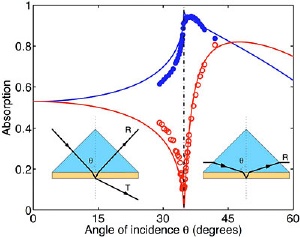Jun 30 2009
It appears to be a paradox: ultra-thin material that absorbs all the incident light. Nonetheless, it does exist. Two Leiden researchers report on their research in 'Applied Physics Letters'. The article is among the Top 20 of the most downloaded articles of this reputable journal in May.

Ideal light detector
The two researchers, Eduard Driessen, MSc, and Dr Michiel de Dood, have demonstrated that at a thickness of 4.5 nanometer niobiumnitride (NbN) is ultra-absorbent. They have recorded a light absorption of almost 100%, while the best light absorption to date was 50%. This research brings the ideal light detector a step closer. A cell made of this material can already collect light and convert it into an electrical signal. The high number of downloads indicates that this research is very special.
Angles and polarisation
Materials that could potentially absorb a lot of light have the problem that they reflect the incident light; they are generally very good mirrors. But how much light is reflected and how much is absorbed depends on two factors: the angle at which the light falls onto the material, and the polarisation (the direction of oscillation) of the light. Light has two kinds of polarisation: s and p polarisation. Polaroid sunglasses make good use of this characteristic. The light absorption of a thin slice of NbN is at its maximum if the light falls on it at an angle of 35º and only consists of s-polarised light. The absorption achieved is then 94%. The p-polarised light is reflected in full. At an angle of 46º the absorption for both polarisation directions is 80%, which is still extremely good.
Applications
This discovery gave Driessen and De Dood the idea for building a special detector. They want to use this detector to view individual light particles, photons. To date this has been very difficult because the absorption was not high enough. The most important part of the detector is a lattice of ultra-absorbent NbN filaments. When an s-light particle falls on the lattice, it is absorbed. A p-particle is reflected. This p-particle can then in turn be collected by a second detector so that all the light is detected. Calculations show that the wavelength (colour) of the light particle has hardly any influence. The detector can therefore also be used for particles with completely different wavelengths, such as detection systems for telecommunications and infra-red equipment.